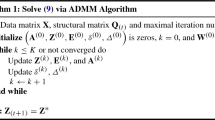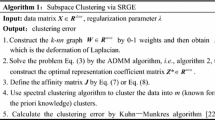Abstract
Greedy subspace clustering methods provide an efficient way to cluster large-scale multimedia datasets. However, these methods do not guarantee a global optimum and their clustering performance mainly depends on their initializations. To alleviate this initialization problem, this paper proposes a two-step greedy strategy by exploring proper neighbors that span an initial subspace. Firstly, for each data point, we seek a sparse representation with respect to its nearest neighbors. The data points corresponding to nonzero entries in the learning representation form an initial subspace, which potentially rejects bad or redundant data points. Secondly, the subspace is updated by adding an orthogonal basis involved with the newly added data points. Experimental results on real-world applications demonstrate that our method can significantly improve the clustering accuracy of greedy subspace clustering methods without scarifying much computational time.
Access this chapter
Tax calculation will be finalised at checkout
Purchases are for personal use only
Similar content being viewed by others
Notes
- 1.
The Hopkins155 database is available online at http://www.vision.jhu.edu/data/hopkins155/.
- 2.
The Extended Yale-B database is available online at http://vision.ucsd.edu/~leekc/ExtYaleDatabase/ExtYaleB.html.
References
Yang, A., Wright, J., Ma, Y., Sastry, S.: Unsupervised segmentation of natural images via lossy data compression. Computer Vis. Image Underst. (CVIU) 110(2), 212–225 (2008)
Vidal, R., Tron, R., Hartley, R.: Multiframe motion segmentation with missing data using powerfactorization and GPCA. Int. J. Comput. Vis. (IJCV) 79(1), 85–105 (2008)
Ho, J., Yang, M.H., Lim, J., Lee, K.C., Kriegman, D.: Clustering appearances of objects under varying illumination conditions. In: Computer Vision and Pattern Recognition (CVPR) (2003)
Hong, W., Wright, J., Huang, K., Ma, Y.: Multi-scale hybrid linear models for lossy image representation. IEEE Trans. Image Process. (TIP) 15(12), 3655–3671 (2006)
Chaudhuri, K., Kakade, S.M., Livescu, K., Sridharan, K.: Multi-view clustering via canonical correlation analysis. In: International Conference on Machine Learning (ICML) (2009)
Zhao, X., Evans, N., Dugelay, J.L.: A subspace co-training framework for multi-view clustering. Pattern Recogn. Lett. (PRL) 41, 73–82 (2014)
Vidal, R.: Subspace clustering. Sign. Process. Mag. 28(2), 52–68 (2011)
Costeira, J., Kanade, T.: A multibody factorization method for independently moving objects. Int. J. Comput. Vis. (IJCV) 29(3), 159–179 (1998)
Kanatani, K.: Motion segmentation by subspace separation and model selection. In: International Conference on Computer Vision (ICCV) (2001)
Vidal, R., Ma, Y., Sastry, S.: Generalized principal component analysis (GPCA). IEEE Trans. Pattern Anal. Mach. Intell. (TPAMI) 27(12), 1945–1959 (2005)
Zhang, T., Szlam, A., Lerman, G.: Median K-flats for hybrid linear modeling with many outliers. In: Proceedings of 2nd IEEE International Workshop on Subspace Methods, pp. 234–241 (2009)
Tipping, M., Bishop, C.: Mixtures of probabilistic principal component analyzers. Neural Comput. 11(2), 443–482 (1999)
Yang, A.Y., Rao, S., Ma, Y.: Robust statistical estimation and segmentation of multiple subspaces. In: Computer Vision and Pattern Recognition Workshop (CVPRW) (2006)
Elhamifar, E., Vidal, R.: Sparse subspace clustering. In: Computer Vision and Pattern Recognition (CVPR) (2009)
Elhamifar, E., Vidal, R.: Sparse subspace clustering: algorithm, theory, and applications. IEEE Trans. Pattern Anal. Mach. Intell. (TPAMI) 35(11), 2765–2781 (2013)
Liu, G., Lin, Z., Yan, S., Sun, J., Yu, Y., Ma, Y.: Robust recovery of subspace structures by low-rank representation. IEEE Trans. Pattern Anal. Mach. Intell. (TPAMI) 35(1), 171–184 (2013)
Zhang, Y., Sun, Z., He, R., Tan, T.: Robust subspace clustering via half-quadratic minimization. In: International Conference on Computer Vision (ICCV) (2013)
Zhang, Y., Sun, Z., He, R., Tan, T.: Robust low-rank representation via correntropy. In: Asian Conference on Pattern Recognition (ACPR) (2013)
Wang, Y., Xu, H., Leng, C.: Provable subspace clustering: when LRR meets SSC. In: Advances in Neural Information Processing Systems (NIPS) (2013)
Chen, G., Lerman, G.: Spectral curvature clustering. Int. J. Comput. Vis. (IJCV) 81(3), 317–330 (2009)
Dyer, E.L., Sankaranarayanan, A.C., Baraniuk, R.G.: Greedy feature selection for subspace clustering. J. Mach. Learn. Res. (JMLR) 14(1), 2487–2517 (2013)
Heckel, R., Bölcskei, H.: Subspace clustering via thresholding and spectral clustering. In: Acoustics, Speech, and Signal Processing (ICASSP) (2013)
Park, D., Caramanis, C.: Greedy subspace clustering. In: Advances in Neural Information Processing Systems (NIPS) (2014)
Donoho, D.L.: For most large underdetermined systems of linear equations the minimal \(l\)1-norm solution is also the sparsest solution. Commun. Pure Appl. Aathematics (CPAA) 59(6), 797–829 (2006)
Tibshirani, R.: Regression shrinkage and selection via the lasso. J. R. Stat. Soc. Series B (Methodological) 58, 267–288 (1996)
Tron, R., Vidal, R.: A benchmark for the comparison of 3-D motion segmentation algorithms. In: Computer Vision and Pattern Recognition (CVPR) (2007)
Lee, K.C., Ho, J., Kriegman, D.: Acquiring linear subspaces for face recognition under variable lighting. IEEE Trans. Pattern Anal. Mach. Intell. (TPAMI) 27(5), 684–698 (2005)
Author information
Authors and Affiliations
Corresponding author
Editor information
Editors and Affiliations
Rights and permissions
Copyright information
© 2015 Springer International Publishing Switzerland
About this paper
Cite this paper
Song, L., Zhang, M., Sun, Z., Liang, J., He, R. (2015). Two-Step Greedy Subspace Clustering. In: Ho, YS., Sang, J., Ro, Y., Kim, J., Wu, F. (eds) Advances in Multimedia Information Processing -- PCM 2015. PCM 2015. Lecture Notes in Computer Science(), vol 9314. Springer, Cham. https://doi.org/10.1007/978-3-319-24075-6_5
Download citation
DOI: https://doi.org/10.1007/978-3-319-24075-6_5
Published:
Publisher Name: Springer, Cham
Print ISBN: 978-3-319-24074-9
Online ISBN: 978-3-319-24075-6
eBook Packages: Computer ScienceComputer Science (R0)




